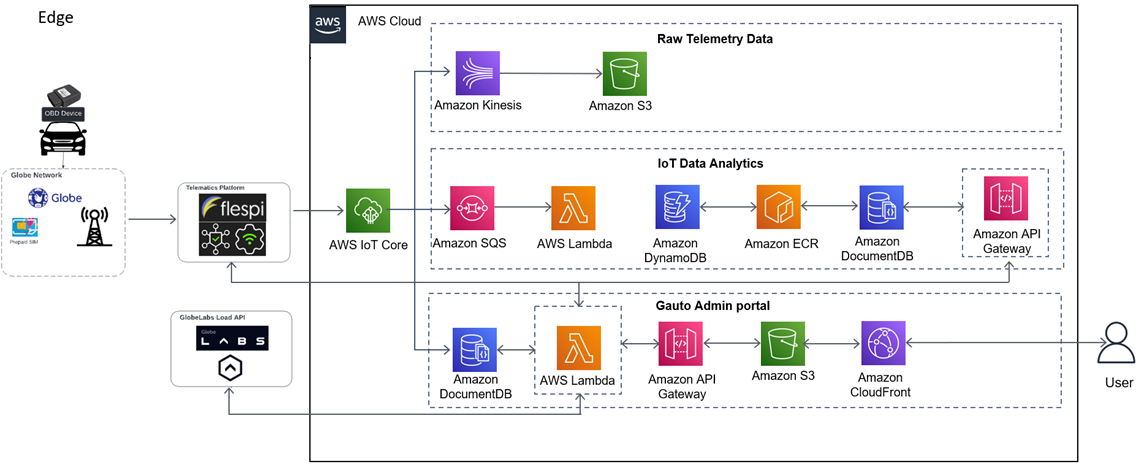AWS Partner Network (APN) Blog
Telemetry-Based Decisions for Auto Loans and Usage-Based Insurance on AWS from Globe Cascadeo
By KC Stegbauer, Sr. Cloud Architect – Cascadeo
By Matt Riordan, Director of Engineering – Cascadeo
By Jared Reimer, Founder and CTO – Cascadeo
By Lalit Mangla and Sefiani Marouane, Sr. Partner Solutions Architects – AWS
 |
| Cascadeo |
 |
The fixed cost of auto insurance is a top concern among automobile owners and drivers. To address this challenge, automobile companies and insurance companies are looking for mechanisms to offer more customized solutions to their customer base.
Usage-based insurance (UBI) programs are supported by telematics and collect data about vehicle usage and driving behaviors, including speeding, harsh braking, and acceleration. With UBI programs, car owners get a driving score which determines their insurance premium—better driving implies lower insurance premiums.
Insurers are looking to achieve the following objectives:
- Offer more competitive and differentiated insurance products to customers.
- Improve estimations related to damages from accidents.
- Gain a deeper understanding of driving behavior and risks.
Policyholders are looking to:
- Reduce car insurance premiums.
- Tailor car insurance to their driving habits.
- Explore more customized offerings from insurance companies.
In this post, we will walk through a vehicle telematics solution and how it can be leveraged by insurers and drivers for usage-based insurance. We will also cover the benefits and tradeoffs of UBI and touch upon other potential use cases for this solution.
Cascadeo is an ICT (information and communication technologies) arm of Globe Telecom, Inc., and is a leading full-service telecommunications company in the Philippines. Globe Cascadeo is an AWS Premier Tier Services Partner and Managed Service Provider (MSP) in ASEAN. Globe operates in the Philippines under the Globe Telecom brand and in the United States via Cascadeo.
Solution Overview
This solution was built as part of the Globe 5G IoT Car Telemetry project and enables insurance companies to offer credits or rewards for good driving behavior. This post provides a general overview of the software design, components, and architecture.
The GV500 MAP (OBD2) devices send both periodic and event-related messages over the 5G network to the receiver (currently Flespi), which translates the message and device information for transmission to AWS IoT Core.
Each message generates an event triggering an AWS Lambda function, which parses the message and extracts the message type, device number, and timestamp. The message is sent in JSON format to a table assigned to the message type, with a primary key of the device number and a sorting key that’s a concatenation of the timestamp and sequential message number from the device.
This enables the data storage to be sharded by devices, allowing horizontal scaling as devices are added as well as rapid device and time-based lookups.
Figure 1 – High-level view of the end-to-end architecture.
On a periodic basis (currently daily), jobs are enqueued in ElastiCache to be run by pods in an Amazon Elastic Kubernetes Service (Amazon EKS) cluster.
Each job represents a calculation based on a specific message type, including the number of:
- Harsh braking events over a period.
- Seconds the vehicle was being driven.
- Seconds the vehicle was idling.
- Seconds the vehicle was driven between midnight and 4 a.m.
- Seconds the vehicle was driven in rush hour traffic.
- Seconds exceeding the speed limit on the road where the car was driving.
- Summary computation of above scores.
These calculations each take less than five minutes to complete. On a daily basis, each score is computed for the previous 1, 7, and 30 days. To ensure the calculations complete in a timely manner, the number of worker nodes can be horizontally scaled. Results are stored in Amazon DocumentDB for retrieval.
Users and devices are added using Amazon API Gateway, and user authentication is performed using Amazon Cognito over the API Gateway. This isolates identity information from the analytics engine and database.
Analytics and Lambda function code are stored as container images in Amazon Elastic Container Registry (Amazon ECR).
Figure 2 – Detailed view of client data.
Success Metrics
Telecom operators should be able to launch the new value-added services along with the telco subscription model that leverages existing connectivity offerings to provide services to financial institutions, public sector (land transport), and insurance companies.
The solution collects telematics data and stores it in a single repository. End users can extract data from the repository, analyze it, and populate their dashboards with it analyze the analytics dashboard. At the same time, local land transport can utilize the aggregate data to look at congested areas and build new infrastructure to avoid future accidents, for example.
Figure 3 – Detailed summary of driving score vs. individual relative score.
Lessons Learned
Customers can benefit from their good driving behavior and reduce premiums paid to the insurance companies. Insurance companies can offer tailored packages to the customers based on their good driving patterns.
It’s important to note that privacy of the customers should always be considered. Insurance companies need to have an up-front governance and personal data protection agreement in place so they do not utilize this data for other purposes or campaigns.
Even if strong data protection and data governance policies are in place, insurees still need to consider if UBI is worth the privacy tradeoff. In the same way, drivers with good patterns can reduce their insurance premiums, drivers who have bad driving habits will increase their premiums.
Moreover, drivers with good habits who could benefit from UBI may not sign up for it simply because they do not feel comfortable having their driving behavior constantly monitored.
Conclusion
By leveraging AWS IoT, Globe was able to develop a cost-effective solution to gather data from cars in order to provide benefits to both insurers and drivers. It enables Globe to offer value-added services beyond connectivity to their users.
If you need help with IoT or data analytics on AWS, contact Globe.
Globe Cascadeo – AWS Partner Spotlight
Cascadeo is an AWS Premier Tier Services Partner and (MSP). Globe operates in the Philippines under the Globe Telecom brand and in the United States via Cascadeo.



